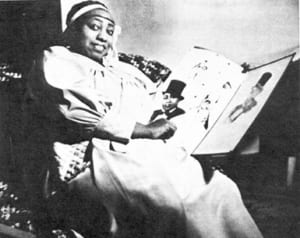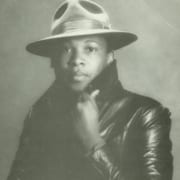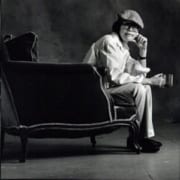Gladys Bentley
Gladys Bentley (1907 – 1960)
Gladys Bentley was born on August 12, 1907. She was the eldest of 4 children born to a Trinidad born mother, Mary Mote (Bentley) and an American born father, George L. Bentley. Gladys left home at 16 years old. Like many African Americans of her generation she ended up in New York City’s Harlem, the capital of “The New Negro “. For Gladys, her lesbianism made her need to strike out on her own all the more urgent. As she would recall many years later in an Ebony Magazine Article, “It seems I was born different. At least, I always thought so….From the time I can remember anything, even as I was toddling, I never wanted a man to touch me…Soon I began to feel more comfortable in boys clothes than in dresses”.
Bentley left Pennsylvania at 16 to be part of the Harlem Renaissance and come out as a bulldagger. She began singing at rent parties and buffet flats and moved on to speakeasies and nightclubs. later she would headline the popular speakeasy the Clam House as well as the Ubangi Club.
She wowed audiences with her powerful voice and obscene parodies of blues standards and show tunes and was famous for her glamorous girlfriends. Very open about her sexuality, Bentley also performed at lesbian bars and once told a gossip columnist she had married a white woman while in Atlantic City, New Jersey.
In the 1920s a large part of the elegant town houses and apartment buildings in both Harlem and downtown in Greenwich Village had been converted into cheap rooming flats. In both neighborhoods, artists and intellectuals flocked to this cheap housing in beautiful surroundings. In both neighborhoods, amongst all this creative talent, there was a large Homosexual population. In Harlem this great creative outpouring was also a celebration of optimism about the future of Black America. This era would later be known as The “Harlem Renaissance”. The list of gay men, lesbians or bisexuals amongst the “Harlem Renaissance” is more or less a guide to many of the most talented people of the era. Langston Hughs, Countee Cullen, Wallace Thurman, Bessie Smith, Ethel Waters, and Moms Mabely just to name a few. Audiences of the prohibition era were always craving something new. There was a “Vogue of the Negro” , accompanied by a curiosity for “Pansy Acts” and “Hot Mama” lebian or bisexual singers.
Advertisement for Mona’s Club 440 in 1942, with the explicit use of the word “gay” featured prominently. The word “gay” during the 1940s also denoted “happy,” and to the casual reader even the reference to “butch,” meaning masculine in gay argot, might have escaped attention.
However, the discerning, sophisticated, 1942 reader would quickly understand that Mona’s Club 440 catered to an almost exclusively woman audience during World War II.
Gladys Bentley carved out a place for herself amidst this curiosity, playing at rent parties and the legendary speakeasies of “Jungle Alley” at 133 between Lenox and Seventh Avenue. She would transform popular tunes of the day with raunchy naughty playful lyrics. Dressed in signature tux and top hat , she openly and riotously flirted with women in the audience. Her popularity and salary was ever increasing , as she was frequently mentioned in many of the entertainment columns of the day.
Characters based on her appeared in novels (Carl Van Vechtens’ “Parties”, Clement Woods “Deep River”, Blair Niles “Strange Brother”). Starting in 1928 ( at age 21) she began a recording career that spanned 2 decades. 8 recordings for the OKeh recording company were followed by a side with the Washboard Serenader’s on the Victor label. Although on her recordings she did not dare have lesbian lyrics , she certainly played up this image in the clubs and in public.
Lois Sobel, a popular columnist of the era, recalled Bentleys announcement of her marriage ceremony with her white female lover in New Jersey. Bentley briefly parlayed her fortunes into a Park Avenue apartment, servants, beautiful car etc. etc. In the 1930s the repeal of Prohibition quickly eroded the prominence of Harlem bistros. Furthermore, the Great Depression seems to have ended much of the “anything goes” spirit of tolerance that had pervaded in the 1920s’. Despite this, initially Bentley was able to hold on by cultivating her homosexual following. In the early 1930’s she was the featured entertainer at Harlem’s’ Ubangi Club, supported by a chorus of men in drag. But by 1937 the glory days of Jungle Alley were very much a thing of the past. Bentley (now aged 30) moved to Los Angeles to live with her mother in a small California bungalow. She was able to maintain some success , particularly during World War 2 when many homosexual bars proliferated on the west coast (capitalizing on the influx of gay men and lesbians from the military) Once again, Bentley carved out a niche for herself in this subculture and environment. Many lesbian women came to see her shows at “Joquins’ El Rancho” in Los Angeles and “Monas” in San Francisco, although on occasion she did have legal trouble for performing in her signature male attire.
In 1945 she recorded 5 discs for the Excelsior label (still not daring to use lesbian lyrics in recordings) including “Thrill Me Till I get My Fill,” “Find Out What He Likes”, and “Notoriety Papa”. However in the 1950s the limited tolerance that had been eroding since the Great Depression, finally collapsed disastrously. The McCarthy “witch hunts” were particularly vicious towards homosexuals.
In light of recent revelations about J. Edgar Hoover, Roy Cohen and possibly McCarthy himself this movement was all the more hypocritical. Although gay and lesbian organizations like The Daughters Of Bilitis and The Mattachine Society were formed at this time, the lives of many homosexuals were ruined. Bentley, who for so long had been one of THE most open as regards her homosexuality, was of course a sitting duck for persecution. Out of desperate fear for her own survival (particularly with an aging mother to support) Gladys Bentley started wearing dresses, and sanitizing her act. In 1950, Bentley wrote a desperate, largely fabricated article for Ebony entitled “I am Woman Again” in which she claimed to have cured her lesbianism via female hormone treatments and was finally at peace after a “hell as terrible as dope addiction”.
She claimed to have married a newspaper columnist named J. T. Gibson (a man who soon after publicly denied that the two had ever wed). In 1952 she does seem to have married a man named Charles Roberts. He was a cook and 16 years younger than Bentley, who lied on the marriage certificate, stating her age as 36 rather than 45. The two eventually divorced. Bentley did manage to still perform, usually at the Rose Room in Hollywood.
She recorded a single on the Flame label and appeared twice on Groucho Marx’s’ television show. At this stage, Bentley became an active and (truly) devoted member of “The Temple of Love in Christ, Inc.”. She was about to become an ordained minister in the church when she died of a flu epidemic in 1960 at the age of 52. These desperate attempts to survive do not diminish her previous accomplishments.





